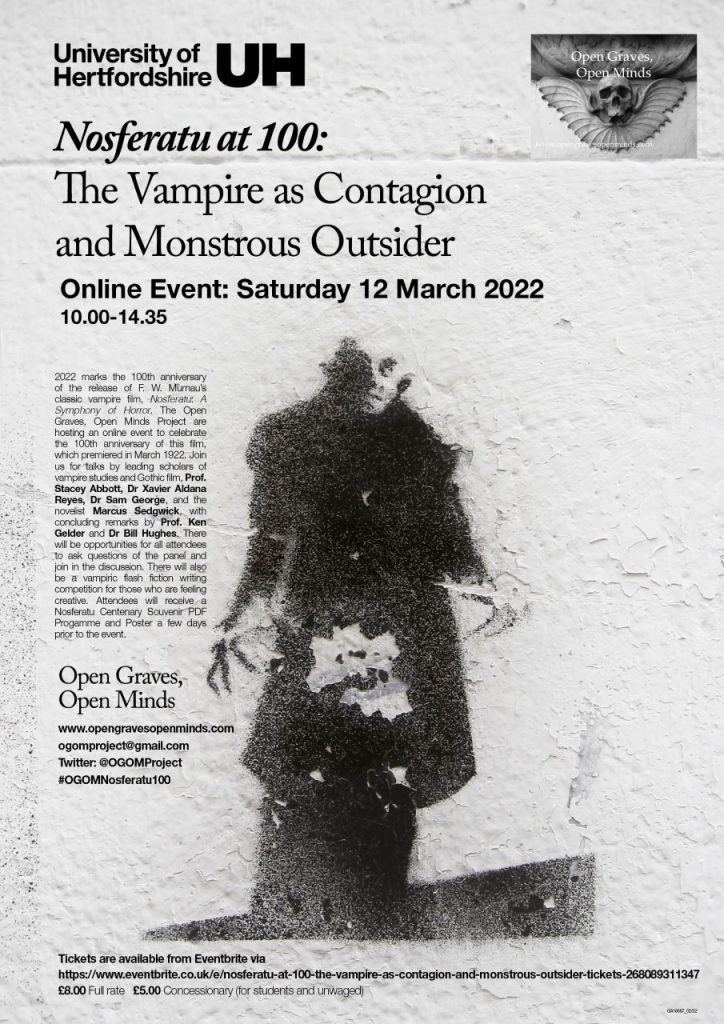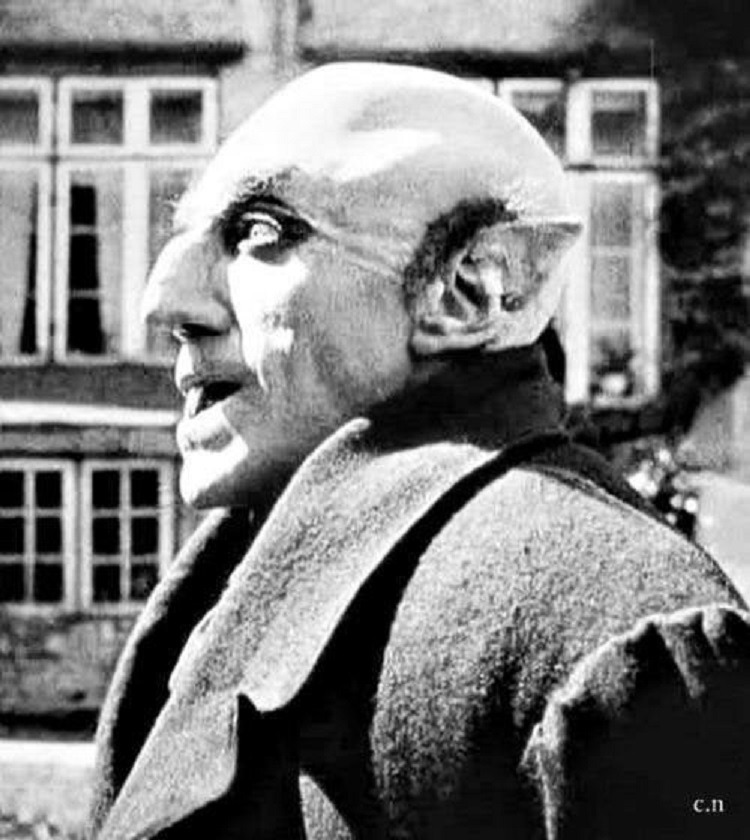Nosferatu at 100: The Vampire as Contagion and Monstrous Outsider
Online Event: Saturday, 12 March 2022, 10.00 – 14.35 GMT
* You can now download a custom-designed souvenir programme and A3 poster here
Follow event on Twitter with #OGOMNosferatu100
* There is a Twitter Moment of the conference here
The winner of the Vampire Flash Fiction competition was Becca Gransbury and you can find all the entries here.

2022 marks the 100th anniversary of the release of F. W. Murnau’s classic vampire film, Nosferatu: A Symphony of Horror. The Open Graves, Open Minds Project are hosting an online event to celebrate the 100th anniversary of this film, which premiered in March 1922. We will have talks by the leading scholars of vampire and Gothic film, Prof. Stacey Abbott, Dr Xavier Aldana Reyes, Dr Sam George, and the novelist Marcus Sedgwick, with concluding addresses by Prof. Ken Gelder and Dr Bill Hughes. There will be opportunities for all attendees to ask questions of the panel and join in discussion. There will also be a vampiric flash fiction writing competition for those who are feeling creative.
The Open Graves, Open Minds Project began in 2010 with extensive research into how that blood-bloated undead monster of East European folklore, the vampire, has been reincarnated through novels, films and other media since the eighteenth century. This led to a groundbreaking international vampire conference in 2010; a book of essays, Open Graves, Open Minds: Representations of Vampires and the Undead from the Enlightenment to the Present Day (2013); and a special issue of the scholarly journal, Gothic Studies on vampire narratives, Open Graves, Open Minds: Vampires and the Undead in Modern Culture (May 2013). Our welcoming of vampires into the academy inspired a pioneering MA module in Vampire Studies, Reading the Vampire: Science, Sexuality and Alterity in Modern Culture, led by Dr Sam George at the University of Hertfordshire. We went on to celebrate the centenary of Bram Stoker’s death with a symposium in 2012; and hosted the bicentenary in 2019 of the publication of John Polidori’s The Vampyre, the first fictional vampire in English. More recently, we have held events on the little-known tale The Black Vampyre, an unusual and provocative story of slavery and rebellion, and the first Black vampire in American literature. OGOM is delighted to continue this vampire extravaganza, with a special centenary event on Murnau’s 1922 film.
Murnau’s Nosferatu 1922 was loosely based on Bram Stoker’s 1897 novel, Dracula, but the protagonist’s and other characters’ names were changed to avoid copyright complications with Stoker’s widow. In the twentieth century the Dracula myth shifted away from Transylvania via the new media of film and was transported to Germany via Murnau’s film. The word that gives the film its title was taken from Stoker, who found it in Emily Gerard’s ‘Transylvanian Superstitions’ as a Romanian word for ‘vampire’ but, in fact, the word does not exist in the Romanian language: the Romanian word for ‘vampire’ is vampir. Gerard seems to have misread or mistranscribed a Romanian word meaning ‘plaguesome’ or ‘insufferable’ (nesuferit). ‘Nosferatu’ is also close to the Greek word nosforos, meaning ‘plague bearer’. In Stoker, the word is used generically but the makers of Nosferatu give it the status of a capitalised proper name. Vampirism and plague are symbolically combined in the metaphor of vermin characterised by the rats, themes in the fairy tale ‘The Pied Piper’ and Stoker’s Dracula.
What is surprising is how the film differs from Stoker’s novel. In Henrik Galeen’s script all the characters’ names have been changed. Dracula is ‘Count Orlok’, Jonathan Harker’s surname becomes ‘Hutter’, and Mina is renamed ‘Ellen’ (though in later prints the names are restored except for Mina, who is named ‘Nina’). Lucy, who is married, has a minor role and Renfield is Hutter’s employer. It turns out that Renfield is insane and enslaved to Orlok. Van Helsing is renamed ‘Bulwer’, and again, in a significant change, is rendered completely powerless against the vampire. There is no ‘crew of light’ in this film: Ellen destroys the vampire through her courageous self sacrifice. The events are shifted into the German towns of either Bremen or Wisborg, depending on the print.

Undoubtedly the most striking feature of the film is Orlok himself, played by Max Shrek (the surname means ‘terror’ in German). He is no Edward Cullen. He has a bald head, pointed ears, a hooked nose and rat-like teeth. His fangs are set at the front of his mouth (rather than being on either side, as is now familiar), underlining his similarity to the rats he brings in his wake. The film relies for its shock value on the grotesqueness of Orlok and on his association with the bubonic plague, which he brings (unwittingly assisted by Harker) into Bremen.
Schedule
10.00–10.10 Welcome
Each talk will be 30 minutes, followed by 10 minutes Q & A
10.10–10.50 Stacey Abbott, ‘Monstrous strain: The horror legacy of Nosferatu’
Prof. Stacey Abbott is Professor of Film and Television at the University of Roehampton.
10.50–11.30 Xavier Aldana Reyes, ‘(Re)framing Nosferatu: Early German Gothic cinema and the visual composition of monsters’
Dr Xavier Aldana Reyes is Reader in English Literature and Film at Manchester Metropolitan University.
11.30–11.45 Break
11.45–12.25 Sam George, ‘Demonised Outsiders: Pied Piper and Dracula myths in Nosferatu – the rat as vampiric totem animal’
Dr Sam George is Associate Professor of Research at the University of Hertfordshire and the Convener of the Open Graves, Open Minds Project.
12.25–13.05 Marcus Sedgwick, ‘Cursed dirt: Contagion in Nosferatu and its ancestors’
Marcus Sedgwick is an award-winning writer for young adults who explores Gothic themes of illness and mortality.
13.05–13.35 Break
13.35–14.05 Nosferatu Reborn
Ken Gelder will respond to the speakers and give an overview of the significance of Nosferatu.
Prof. Ken Gelder is Professor of Culture and Communication at the University of Melbourne.
Bill Hughes, ‘A century of vampire love: The longevity of the monstrous outsider from Nosferatu to paranormal romance’
Dr Bill Hughes is co-convenor of the Open Graves, Open Minds Project.
14.05–14.35 Vampire Flash Fiction Writing (40-50 words)
Booking: Tickets are available from Eventbrite. Delegates will receive a Centenary Souvenir PDF Progamme and Poster designed specially for the event a few days prior to the 12th March!!!
Fees:
£8.00 Full rate
£5.00 Concessionary (for students and unwaged)
Resources: We have set up a page with links to the film and some suggested reading material. They give some background to the talks and may inspire you for the flash fiction contest!
Follow event on Twitter with #OGOMNosferatu100
